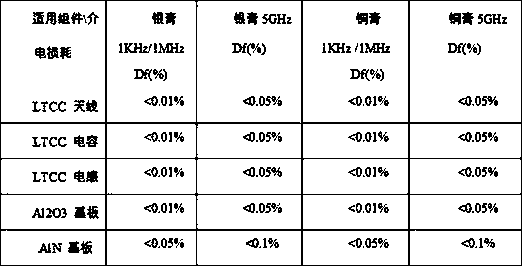Low-temperature co-fired ceramic colloid and preparation method and application thereof
A low-temperature co-fired ceramic and colloid technology, applied in metal processing equipment, transportation and packaging, etc., can solve the problems of poor high-frequency conductivity and high price
- Summary
- Abstract
- Description
- Claims
- Application Information
AI Technical Summary
Problems solved by technology
Method used
Image
Examples
Embodiment 1
[0029] A preparation method of low temperature co-fired ceramic colloid, comprising the steps of:
[0030] The first step, weigh B according to the ratio of parts by mass 2 o 3 20-50 parts, ZnO 20-50 parts, Al 2 o 3 1-5 parts, SrO 0.5-5 parts, Na 2 O 1-10 parts, Li 2 O 0.5-5 parts, SiO 2 1-15 servings, the B 2 o 3 , ZnO, Al 2 O, SrO, Na 2 O. Li 2 O and SiO 2Stir and mix, put it into the crucible carrier after mixing, then heat the crucible carrier in a resistance furnace to 1000-1500°C for melting, hold the temperature for 2-4 hours, and then quickly pour it into deionized water for water quenching to obtain Melt the glass block, grind the molten glass block into glass powder through a coarse grinder, a fine grinder and a bead mill in sequence, and measure the softening point of the glass powder by using a thermogravimetric measuring device TG-DTA instrument at 400°C-900°C °C, and finally grind for 24 hours with a wet zirconium ball mill to obtain Li with an ave...
Embodiment 2
[0037] A preparation method of low temperature co-fired ceramic colloid, comprising the steps of:
[0038] The first step, weigh B according to the ratio of parts by mass 2 o 3 20-50 parts, ZnO 20-50 parts, Al 2 o 3 1-5 parts, SrO 0.5-5 parts, Na 2 O 1-10 parts, Li 2 O 0.5-5 parts, SiO 2 1-15 servings, the B 2 o 3 , ZnO, Al 2 O, SrO, Na 2 O. Li 2 O and SiO 2 Stir and mix, put it into the crucible carrier after mixing, then heat the crucible carrier in a resistance furnace to 1000-1500°C for melting, hold the temperature for 2-4 hours, and then quickly pour it into deionized water for water quenching to obtain Melt the glass block, grind the molten glass block into glass powder through a coarse grinder, a fine grinder and a bead mill in sequence, and measure the softening point of the glass powder by using a thermogravimetric measuring device TG-DTA instrument at 400°C-900°C °C, and finally grind for 24 hours with a wet zirconium ball mill to obtain Li with an av...
Embodiment 3
[0044] A preparation method of low temperature co-fired ceramic colloid, comprising the steps of:
[0045] The first step, weigh B according to the ratio of parts by mass 2 o 3 20-50 parts, ZnO 20-50 parts, Al 2 o 3 1-5 parts, SrO 0.5-5 parts, Na 2 O 1-10 parts, Li 2 O 0.5-5 parts, SiO 2 1-15 servings, the B 2 o 3 , ZnO, Al 2 O, SrO, Na 2 O. Li 2 O and SiO 2 Stir and mix, put it into the crucible carrier after mixing, then heat the crucible carrier in a resistance furnace to 1000-1500°C for melting, hold the temperature for 2-4 hours, and then quickly pour it into deionized water for water quenching to obtain Melt the glass block, grind the molten glass block into glass powder through a coarse grinder, a fine grinder and a bead mill in sequence, and measure the softening point of the glass powder by using a thermogravimetric measuring device TG-DTA instrument at 400°C-900°C °C, and finally grind for 24 hours with a wet zirconium ball mill to obtain Li with an av...
PUM
| Property | Measurement | Unit |
|---|---|---|
| The average particle size | aaaaa | aaaaa |
Abstract
Description
Claims
Application Information
 Login to View More
Login to View More - R&D
- Intellectual Property
- Life Sciences
- Materials
- Tech Scout
- Unparalleled Data Quality
- Higher Quality Content
- 60% Fewer Hallucinations
Browse by: Latest US Patents, China's latest patents, Technical Efficacy Thesaurus, Application Domain, Technology Topic, Popular Technical Reports.
© 2025 PatSnap. All rights reserved.Legal|Privacy policy|Modern Slavery Act Transparency Statement|Sitemap|About US| Contact US: help@patsnap.com

